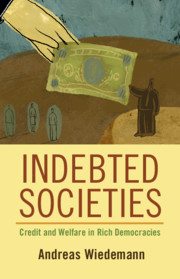Book contents
- Frontmatter
- Contents
- List of Figures
- List of Tables
- Acknowledgments
- 1 Credit and Welfare in Rich Democracies
- 2 A Social Policy Theory of Everyday Borrowing
- 3 Financial Shortfalls and the Role of Welfare States
- 4 Credit Regimes and Patterns of Household Indebtedness
- 5 Borrowing to Address Labor Market Risks
- 6 Borrowing during the Life Course
- 7 The Political and Socioeconomic Consequences of Credit and Debt
- 8 Implications and Conclusion
- Appendix
- Bibliography
- Index
- Series page
2 - A Social Policy Theory of Everyday Borrowing
Published online by Cambridge University Press: 18 June 2021
- Frontmatter
- Contents
- List of Figures
- List of Tables
- Acknowledgments
- 1 Credit and Welfare in Rich Democracies
- 2 A Social Policy Theory of Everyday Borrowing
- 3 Financial Shortfalls and the Role of Welfare States
- 4 Credit Regimes and Patterns of Household Indebtedness
- 5 Borrowing to Address Labor Market Risks
- 6 Borrowing during the Life Course
- 7 The Political and Socioeconomic Consequences of Credit and Debt
- 8 Implications and Conclusion
- Appendix
- Bibliography
- Index
- Series page
Summary
This chapter lays out the social policy theory of everyday borrowing. It discusses the extent to which welfare states protect against social risks and provide social investments. In many countries such services have become insufficient in light of fragmented employment patterns and life course trajectories, resulting in increased demand for private coping mechanisms to address financial gaps due to volatile incomes, earnings losses, and rising expenditures. It introduces the concept of credit regimes, arguing that the institutional structures and regulatory and policy environments shape credit regimes’ permissiveness and households’ access to credit. The chapter explains how the constellation of welfare state and credit regime structures shapes the role of credit as a coping mechanism. When credit regimes are permissive, households borrow to address social risks and use credit as social investments. Credit either substitutes for or complements welfare states depending on which groups social policies protect and support. By contrast, when credit regimes are restrictive, households draw on savings, utilize family support, or cut expenditures because the borrowing option is precluded. The reliance on credit markets instead of social policies reflects a much more fundamental transformation of social rights, social responsibilities, and the allocation of resources and risks.
Keywords
- Type
- Chapter
- Information
- Indebted SocietiesCredit and Welfare in Rich Democracies, pp. 26 - 56Publisher: Cambridge University PressPrint publication year: 2021

